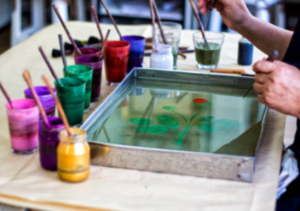Introduction to Sustainable Paint Manufacturing
The principles of sustainable paint manufacturing are essential in addressing the growing concerns surrounding environmental degradation and the toxicity of traditional coatings. As the world increasingly shifts towards eco-friendliness, the coatings industry is recognizing the importance of adopting sustainable practices. Sustainable paint manufacturing encompasses a range of methodologies aimed at minimizing the ecological footprint of paint products, which typically involve the use of solvent-based formulations that release volatile organic compounds (VOCs) into the atmosphere. These compounds not only contribute to air pollution but can also pose health risks to consumers and workers alike.
Global trends in sustainability are markedly influencing the coatings sector. The push towards greener products is driven by consumer demand for safer, environmentally friendly alternatives and regulations aimed at limiting harmful emissions. Innovations such as water-based paints, natural pigments, and bio-based materials are gaining prominence as manufacturers seek to reduce their dependence on petroleum-derived ingredients. These developments are vital in fostering a more sustainable approach to paint production, which seeks to harmonize performance with ecological responsibility.
The impact of traditional paint manufacturing methods on the environment is considerable. Not only do they consume limited natural resources, but they also generate significant waste and pollution throughout the lifecycle of the product, from production through application to disposal. By understanding these adverse effects, stakeholders can appreciate the need for a transformative approach in the coatings industry. Transitioning to sustainable paint manufacturing is not just a trend; it is a necessary evolution that aligns with the global commitment to environmental stewardship. By implementing eco-friendly practices, the paint industry can play a crucial role in promoting sustainability and wellness, thereby contributing to a healthier planet.
Raw Materials and Their Sourcing
In the realm of eco-friendly coatings, the selection and sourcing of raw materials play a crucial role in fostering sustainable paint manufacturing practices. Traditionally, many paints have relied on petroleum-based ingredients, which contribute to environmental degradation. However, the shift towards sustainable alternatives is reshaping the industry. Sustainable paints now utilize renewable, non-toxic, and biodegradable materials, focusing on minimizing the ecological footprint.
Among the primary raw materials used in eco-friendly paints are plant-based oils, natural resins, and pigments derived from minerals or vegetable sources. These ingredients not only reduce the reliance on harmful chemicals but also promote healthier indoor air quality. For instance, linseed oil, extracted from flax seeds, serves as an effective binding agent, while varied earth pigments provide vibrant color without toxic content. The transition to these alternatives highlights the importance of both functionality and safety in sustainable coatings.
Sourcing practices significantly impact the sustainability of paint products. One of the key strategies is to prioritize local suppliers, which reduces transportation emissions and supports local economies. Additionally, sourcing from sustainably harvested resources ensures that raw materials are extracted in a manner that does not compromise the integrity of ecosystems. This practice is paramount, as it encourages responsible forestry and farming practices, thereby enhancing the conservation of biodiversity.
Moreover, manufacturers are increasingly conducting lifecycle assessments of their supply chains to identify opportunities for improvement in sourcing practices. By minimizing waste and choosing suppliers who adhere to sustainable methodologies, companies can significantly enhance the overall sustainability of their eco-friendly coatings. As the demand for sustainable paint products continues to grow, these impactful choices in raw material sourcing will remain vital for the industry’s transformation towards a greener future.

Energy Efficiency in Production
In the quest for sustainability, the paint manufacturing industry has taken significant strides towards enhancing energy efficiency during production. One of the foremost approaches is the adoption of renewable energy sources. By implementing solar panels and wind turbines, manufacturers can substantially reduce their reliance on fossil fuels, thus decreasing greenhouse gas emissions associated with traditional energy consumption. This transition promotes a more sustainable production environment while also lowering operating costs in the long run.
Additionally, incorporating energy recovery systems plays a pivotal role in optimizing energy usage. Techniques such as heat recovery allow manufacturers to capture and reuse waste heat generated during production. This not only improves overall efficiency but also minimizes energy loss, further contributing to a reduced carbon footprint. By utilizing these systems, manufacturers can ensure that energy is used more judiciously, streamlining processes and diminishing waste.
Improved manufacturing processes also promise advancements in energy efficiency. Techniques such as lean manufacturing focus on minimizing waste in every form, including energy. This method emphasizes the importance of continuous improvement and waste elimination throughout the production cycle. By optimizing processes, manufacturers can significantly enhance their energy consumption rates, often achieving reductions of up to 30% in some cases.
Moreover, the implementation of advanced technologies, such as automation and smart manufacturing systems, enables real-time monitoring and control of energy usage. These systems can identify inefficiencies and suggest modifications in production schedules or processes, further promoting energy savings. Through the integration of these innovative solutions, manufacturers are not only advancing their commitment to sustainability but are also paving the way for a more responsible approach to paint production that prioritizes energy efficiency.

Reducing Waste and Emissions
In the realm of sustainable paint manufacturing, effective waste management and emission reduction strategies are critical. Moreover, these strategies not only enhance the ecological footprint of manufacturing processes but also contribute to the overall efficiency of production. Manufacturers are increasingly adopting eco-friendly approaches that prioritize recycling initiatives and closed-loop systems to mitigate waste.
One noteworthy strategy in reducing waste involves the implementation of recycling initiatives. This includes reclaiming unused paint materials and solvents, which can then be reprocessed and reused in the production of new products. By optimizing the lifecycle of raw materials, manufacturers can effectively minimize the volume of waste entering landfills, thus promoting a more circular economy. Additionally, many companies are exploring alternative materials that are more sustainable, resulting in reduced environmental impact and waste generation.
The adoption of closed-loop systems further emphasizes the importance of waste reduction in sustainable paint manufacturing. In a closed-loop system, waste generated during production is recycled back into the manufacturing process. This not only minimizes waste output but also conserves valuable resources by preventing the depletion of new raw materials. Manufacturers employing this strategy report significant reductions in both operational costs and environmental footprints.
To complement these initiatives, the integration of advanced emission control technologies plays a vital role in promoting sustainability. Techniques such as low-VOC (Volatile Organic Compounds) formulations, electrostatic spray application, and activated carbon filtration systems can markedly reduce harmful emissions during manufacturing. By adopting these technologies, paint manufacturers can significantly limit their contribution to air pollution, consequently ensuring compliance with environmental regulations and promoting public health.
Through the combined efforts of recycling initiatives, closed-loop systems, and advanced emission control technologies, sustainable paint manufacturers are setting an example for the industry, paving the way for a more responsible and eco-conscious future.
Water Conservation Practices
Water conservation is a critical aspect of sustainable paint manufacturing practices. The paint industry traditionally consumes substantial water throughout the production process, which can have detrimental effects on local ecosystems and communities. Recognizing this, manufacturers are increasingly adopting innovative techniques to reduce water usage and mitigate environmental impact.
One effective method for water conservation in paint manufacturing is the implementation of water recycling systems. These systems capture and treat wastewater generated during production, allowing it to be reused in various stages of the manufacturing process. By recycling water, manufacturers reduce their reliance on freshwater sources and diminish the overall water footprint of their operations. Additionally, improved treatment processes ensure that any pollutants are removed before the water is reintroduced into the production cycle, promoting safe environmental practices.
Besides recycling, many companies are also investing in advanced technology to monitor and assess their water usage. Utilizing data analytics can help identify areas where water consumption can be minimized, fostering a culture of accountability and efficiency. Even simple measures, such as optimizing equipment and processes to use less water, can lead to substantial savings.
The impact of water usage goes beyond just the paint manufacturing facility. Excessive withdrawal of water can strain local water supplies and disrupt nearby ecosystems. Communities that depend on these resources can suffer from reduced water availability, which can lead to agricultural challenges and economic hardship. Therefore, implementing effective water conservation practices is not only environmentally responsible but also crucial for ensuring that local communities have access to necessary water resources.
In conclusion, the significance of water conservation in paint manufacturing cannot be overstated. By adopting water recycling systems, monitoring consumption, and optimizing processes, manufacturers can significantly reduce their impact on both the environment and local communities, fostering a more sustainable future for the industry.
Quality Control and Safety Standards
In the realm of sustainable paint manufacturing, adherence to quality control protocols and safety standards is paramount. Manufacturers recognize that the integrity of their products goes hand in hand with environmental responsibility. To meet these dual objectives, eco-friendly paint companies implement comprehensive quality assurance programs that are designed to ensure not only the performance of their coatings but also the safety profiles of the materials used in production.
A significant aspect of quality control involves the rigorous testing of raw materials. Sustainable manufacturers often prioritize sourcing ingredients that are free from harmful compounds and are derived from renewable resources. This eliminates the need for toxic solvents and heavy metals, which can be detrimental to both human health and the environment. Advanced analytical techniques are employed to assess the purity and safety of these materials. This commitment to using safer ingredients helps align with stricter safety regulations and certifications, such as the Green Seal and Eco Label, that endorse environmentally friendly practices.
Furthermore, eco-friendly paint manufacturers conform to various regulatory frameworks that govern workplace safety and product safety. Guidelines established by entities such as the Occupational Safety and Health Administration (OSHA) and the Environmental Protection Agency (EPA) ensure that the manufacturing process is not only efficient but also protective of the workers’ health. Training and regular audits are essential components of these safety programs, enabling companies to maintain high standards while mitigating risks associated with hazardous materials.
In addition to regulatory compliance, manufacturers often pursue certifications that validate their commitment to quality and sustainability. Certifications such as LEED (Leadership in Energy and Environmental Design) exemplify an organization’s dedication to eco-friendly practices and the continual improvement of product quality. By focusing on these aspects, sustainable paint manufacturers successfully navigate the complex balance of quality assurance and environmental stewardship, ultimately elevating the standards within the industry.

Consumer Education and Awareness
As the world becomes increasingly aware of environmental issues, the significance of consumer education regarding sustainable paint options cannot be overstated. Sustainable paint products are formulated to minimize negative environmental impacts, and it is vital for consumers to understand the benefits of these eco-friendly coatings. By equipping consumers with information about sustainable alternatives, we can foster a more informed market that favors eco-conscious choices.
One effective approach to educating consumers is through clear and informative labeling on paint products. Labels can provide essential details about the ingredients, environmental certifications, and any relevant sustainability claims. For instance, products labeled as low-VOC (volatile organic compounds) signify a lesser environmental impact and improved indoor air quality. Such transparency not only informs buyers but also encourages them to choose sustainable paints over traditional options, thus creating a shift in demand.
Marketing campaigns play a pivotal role in raising awareness about eco-friendly paint products. Companies can utilize various platforms, including social media, blogs, and websites, to communicate the importance of sustainable coatings. Creative storytelling and highlighting real-life benefits can resonate with potential customers, making them more likely to opt for eco-friendly solutions. Furthermore, engaging visual content showcasing the aesthetic and functional advantages of sustainable paints can elevate consumer interest and drive sales.
In addition to labeling and marketing, community outreach programs can significantly enhance consumer education. Workshops, seminars, and local events focused on sustainable living can help bridge the gap between consumer knowledge and eco-friendly choices. By collaborating with industry experts, businesses can provide significant insights into the importance of choosing eco-friendly paints, ultimately empowering communities to make informed decisions.
Through strategic education and awareness efforts, we can cultivate a strong market demand for sustainable paint options, ensuring a brighter, greener future for generations to come.

Innovative Technologies Driving Change
The landscape of sustainable paint manufacturing is rapidly evolving, largely due to innovative technologies that are transforming the industry. One of the most prominent advancements is the development of bio-based paints. These formulations utilize natural materials derived from plants, reducing reliance on traditional petroleum-based chemicals. By leveraging substances such as soy, corn, and other renewable resources, bio-based paints significantly lower the environmental impact associated with conventional paint production. This shift not only contributes to sustainability but also enhances the appeal of these products due to their lower levels of volatile organic compounds (VOCs), which are harmful pollutants frequently found in traditional coatings.
Another exciting area of development is smart coatings, which integrate advanced technologies to deliver added functionalities beyond mere aesthetics. For instance, some smart coatings now exhibit self-cleaning properties, using photocatalytic reactions to break down dirt and pollutants when exposed to light. This innovation not only improves maintenance efficiency but also prolongs the life of surfaces, thereby reducing waste associated with frequent repainting. Additionally, there are coatings with adaptive properties that can change color or texture in response to environmental conditions, providing functional benefits that enhance user experience while promoting sustainability.
Emerging solutions like nano-coatings also play a crucial role in modern paint manufacturing. Nano-coatings utilize nanoparticles to create protective layers that are thinner, lighter, and more effective than traditional coatings. These coatings often exhibit enhanced durability and resistance to chemicals, UV light, and corrosion, extending the lifespan of the painted surface. Such advancements not only promote sustainability through reduced material usage but also align with the increasing demand for high-performance coatings in various applications, from industrial to residential settings. The continuous exploration of innovative technologies signifies a promising future for the sustainable paints sector, fostering a shift towards greener manufacturing practices.
The Future of Sustainable Paint Manufacturing
The paint manufacturing industry is on the cusp of significant evolution, primarily driven by increasing awareness of environmental impacts and a shift in consumer preferences towards more sustainable options. In the years to come, we can expect a growing emphasis on eco-friendly coatings that not only meet aesthetics and functionality but also prioritize sustainability. These changes are fueled by stringent regulations aimed at reducing volatile organic compounds (VOCs) and harmful chemicals traditionally found in paints. As governments worldwide tighten their emissions standards, manufacturers will be compelled to innovate and adopt greener practices.
Moreover, ongoing advancements in technology will play a crucial role in shaping the future landscape of sustainable paint manufacturing. Innovations such as bio-based raw materials and the development of waterborne formulations are gaining traction. These materials are derived from renewable resources, reducing reliance on petrochemical products. Furthermore, smart coatings that can adapt to environmental conditions or provide self-cleaning properties are under exploration, promising to enhance the durability and longevity of painted surfaces, thereby reducing the frequency of repainting and waste.
Consumers are increasingly discerning about the products they purchase, seeking those that align with their values—particularly sustainability. As eco-consciousness becomes more mainstream, brands are likely to respond by developing a broader range of sustainable paint options. Transparency in sourcing and manufacturing processes will become vital for success; companies that can effectively communicate their sustainability efforts will likely gain a competitive edge in the market.
Challenges remain, however. The initial costs associated with developing and adopting sustainable practices can be daunting for some manufacturers. Additionally, overcoming consumer skepticism about the performance of eco-friendly coatings compared to traditional options will be essential. Engaging in education and outreach will be critical to alleviate apprehensions and showcase the benefits of sustainable alternatives in the paint industry.


